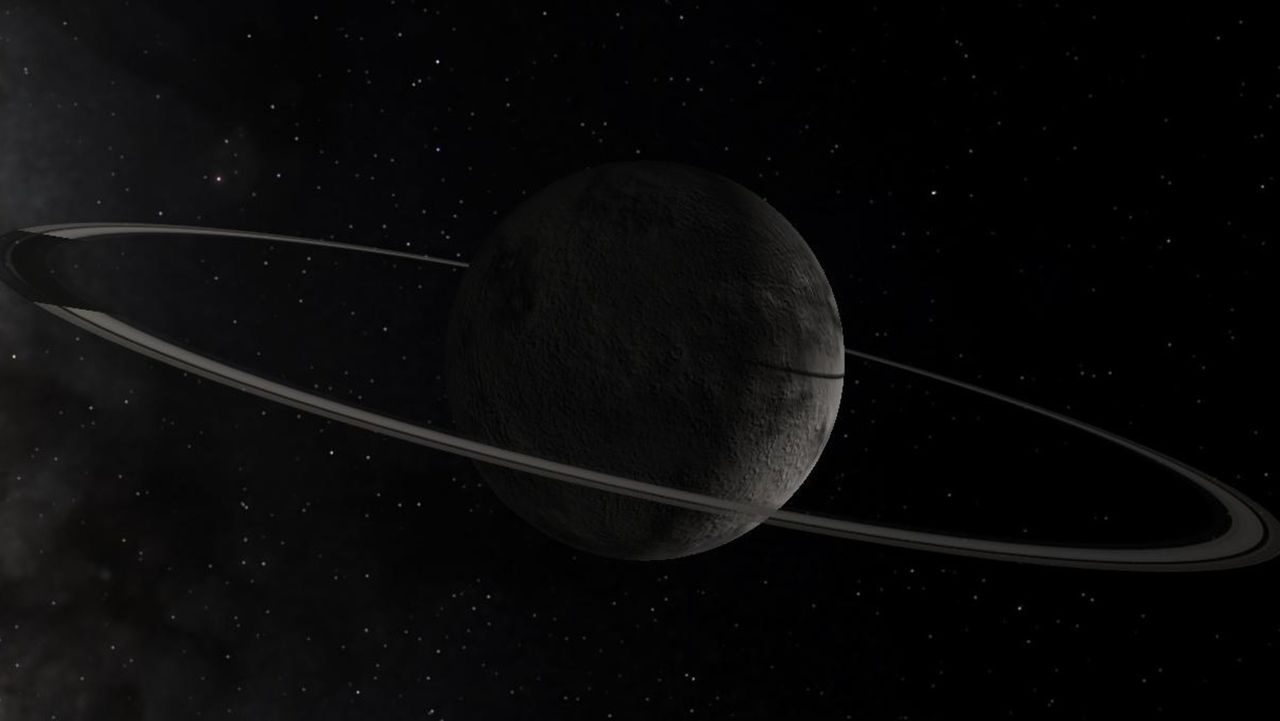Science
Astronomers Discover Forming Rings Around Centaur Chiron

Astronomers have made a groundbreaking discovery by observing the formation of a ring system around the centaur 2060 Chiron, marking the first time such a phenomenon has been documented. This finding, derived from data collected at Brazil’s Pico dos Dias Observatory in 2023, reveals that Chiron is encircled by four distinct rings along with additional diffuse material.
Understanding Chiron and its Unique Rings
First identified in 1977, Chiron is classified as a centaur, a type of celestial object found between the orbits of Jupiter and Neptune. These bodies exhibit characteristics of both comets and asteroids. Chiron, which orbits the Sun between Saturn and Uranus, has a diameter of approximately 200 kilometers (about 125 miles) and is composed of rock, water ice, and organic compounds.
The recently discovered rings appear to consist of water ice and rocky material, potentially originating from a collision between Chiron and another celestial body. The rings are located at varying distances from Chiron’s center: approximately 273 kilometers (about 170 miles), 325 kilometers (about 202 miles), 438 kilometers (about 272 miles), and 1,400 kilometers (about 870 miles). Researchers have noted that the outermost ring may not possess the stability required to be classified as a permanent feature, necessitating further observations.
Implications of the Discovery
What makes Chiron’s ring system particularly fascinating is its ongoing development. This observation of an evolving ring system is unprecedented, providing valuable insights into the processes governing the formation of rings and satellites around smaller celestial bodies. By comparing the latest observations with data from previous years, specifically from 2022, 2018, and 2011, researchers observed rapid changes in the ring structure.
“It is an evolving system that will help us understand the dynamical mechanisms governing the creation of rings and satellites around small bodies, with potential implications for various types of disk dynamics in the universe,” said Braga Ribas, an astronomer at the Federal University of Technology-Parana and co-author of the study.
The findings have been documented in a study published in the Astrophysical Journal Letters on October 14, 2025. This discovery not only expands our understanding of ring systems beyond the well-known examples of Saturn, Uranus, Neptune, and Jupiter but also sheds light on the dynamic processes that shape these intriguing celestial formations.
As astronomers continue to monitor Chiron and its evolving rings, this research could provide essential clues about the broader mechanisms at play in the universe, potentially informing future studies of similar celestial bodies.
-

 Politics1 week ago
Politics1 week agoDallin H. Oaks Assumes Leadership of Latter-day Saints Church
-

 Sports1 week ago
Sports1 week agoSteve Kerr Supports Jonathan Kuminga After Ejection in Preseason Game
-

 Lifestyle1 week ago
Lifestyle1 week agoDua Lipa Celebrates Passing GCSE Spanish During World Tour
-

 Business1 week ago
Business1 week agoTyler Technologies Set to Reveal Q3 2025 Earnings on October 22
-

 Entertainment1 week ago
Entertainment1 week agoZoe Saldana Advocates for James Cameron’s Avatar Documentary
-

 World1 week ago
World1 week agoD’Angelo, Iconic R&B Singer, Dies at 51 After Cancer Battle
-

 Science1 week ago
Science1 week agoChicago’s Viral ‘Rat Hole’ Likely Created by Squirrel, Study Reveals
-

 Lifestyle1 week ago
Lifestyle1 week agoKelsea Ballerini Launches ‘Burn the Baggage’ Candle with Ranger Station
-

 Health1 week ago
Health1 week agoRichard Feldman Urges Ban on Menthol in Cigarettes and Vapes
-

 Health1 week ago
Health1 week agoCommunity Unites for Seventh Annual Mental Health Awareness Walk
-

 Business1 week ago
Business1 week agoMega Millions Jackpot Reaches $600 Million Ahead of Drawings
-

 Business1 week ago
Business1 week agoMLB Qualifying Offer Jumps to $22.02 Million for 2024









